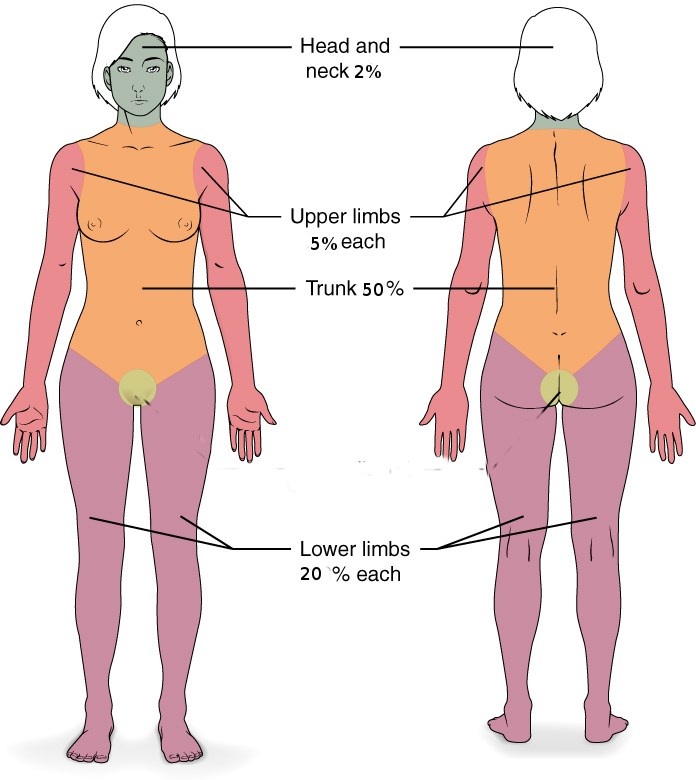Rule of Fives (Burn Percent)
Tags | |
UUID | 9505688b-6596-11e7-9770-bc764e2038f2 |
The Rule of Fives calculator computes the percent of a Body Surface Area that is burned based on the Rule of Fives often used for obese patients.
INSTRUCTIONS: Enter the following:
- (H) Indicate the portion of the head burned: None, Quarter, Half, Three Fourths, Complete
- (LA) Indicate the portion of the left arm burned: None, Quarter, Half, Three Fourths, Complete
- (RA) Indicate the portion of the right arm burned: None, Quarter, Half, Three Fourths, Complete
- (T) Indicate the portion of the chest burned: None, Quarter, Half, Three Fourths, Complete
- (LL) Indicate the portion of the left leg burned: None, Quarter, Half, Three Fourths, Complete
- (RL) Indicate the portion of the right leg burned: None, Quarter, Half, Three Fourths, Complete
Percent BSA: The calculator returns the percent of the burned Body Surface Area.
Related Calculators:
- To compute the Replacement Fluid Requirement for a burn victim using the Parkland Formula, CLICK HERE.
- To compute the Body Surface Area using the Mosteller, Gahan and George, Boyd, DuBois, Haycock, Fujimoto, Takahira or Wang Hihara formulas, [Private Equation].
 Burn Percentage
Burn Percentage
Burn Surface Area
The Rule of Fives can be used to approximate the percent of a patient that is burned. It applies a percent of Body Surface Area, and differs from the Wallace Rule of Nines and often used for obese patients. It applies a larger portion of the body surface area to the trunk and legs as follows:
- (2%) Entire head
- (5%) Complete left arm
- (5%) Complete right arm
- (50%) Trunk
- (20%) Complete left leg
- (20%) Complete right leg
Body Surface Area (BSA) is the measured or calculated surface area of a human body frequently used in physiology and medicine. For many clinical purposes BSA is a better indicator of metabolic mass than body weight because it is less affected by abnormal adipose mass. Estimation of BSA is simpler than many measures of volume.
| BSA Calculators vs Inputs | |||
| Method | Height | Weight | Gender |
| Mosteller | x | x | |
| Gehan and George | x | x | |
| Boyd | x | x | |
| DuBois | x | x | |
| Haycock | x | x | |
| Fujimoto | x | x | |
| Takahira | x | x | |
| Schlick | x | x | x |
| Costeff | x | ||
| Wang Hihara | x | x | |
Demographic BSA Means
| Age Range | Male | Female |
|---|---|---|
| Neonate | 0.243 m² | 0.234 m² |
| 2 years old | 0.563 m² | 0.54 m² |
| 5 years old | 0.787 m² | 0.771 m² |
| 10 years old | 1.236 m² | 1.245 m² |
| 13 years old | 1.603 m² | 1.55 m² |
| 18 years old | 1.98 m² | 1.726 m² |
| 20 to 79 years old | 2.06 m² | 1.83 m² |
| 80 and above | 1.92 m² | 1.638 m² |
Body Surface Area (BSA) Calculators
- Mosteller formula Body Surface Area Calculator
- Gehan and George formula Body Surface Area Calculator
- Boyd formula Body Surface Area Calculator
- DuBois formula Body Surface Area Calculator
- Haycock formula Body Surface Area Calculator
- Fujimoto formula Body Surface Area Calculator
- Takahira formula Body Surface Area Calculator
- Costeff formula Body Surface Area Calculator
- Wang Hihara Body Surface Area Calculator
- Schlick Body Surface Area Calculator
- Body Surface Area Comparison with Averages
Other BSA Applications
- The BSA Compare function lets you enter a body surface area and choose a demographic (above) to compute the percent compared to the mean.
- Wallace Rule of Nines: This computes a percentage of the human body for burn victims based on percentages allocated to different body parts.
- Rule of Fives: This computes a percentage of the human body for obese burn victims.
- Parkland Replacement Fluid: This compute the volume of replacement fluids needed in the first 24 hours based on the patients weight (mass) and the percent of their body that has been burned.
- BSA Percent: This computes a body surface area based on the total body surface area and a percent..
References:
- Image of Human Body from OpenStax College. Used through CC 3.0. Source Anatomy & Physiology, Connexions Web site. http://cnx.org/content/col11496/1.6/, Jun 19, 2013.
Dedication
- For my Scout.
Calculators
Collections
- Comments
- Attachments
- Stats
No comments |

